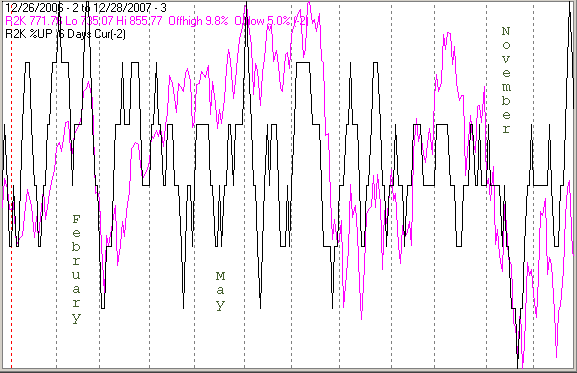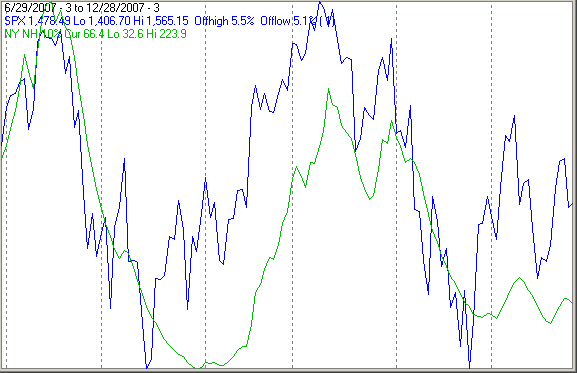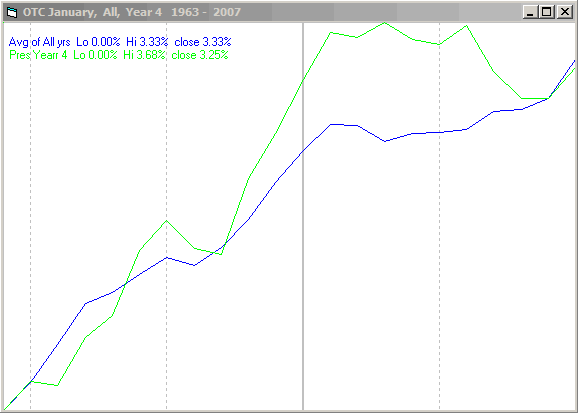January Usually Strong for Stock Markets
Stock-Markets / US Stock Markets Dec 30, 2007 - 03:15 AM GMTBy: Mike_Burk
The good news is: Most of the major indices will finish up for the year.
Short Term - As of last Wednesday the market was overbought.
The Russell 2000 (R2K) had been up for 6 consecutive days as of Wednesday's close and that had happened 3 other times in the past year.
The first time was on February 2 after which the market took a day off and resumed its upward move to a high ending with 7 consecutive up days on February 22. The R2K tumbled 6.1% following the February high, the S&P 500 (SPX) fell 4.4%.
The third time the indices moved up for 6 consecutive days was on June 4 after which the R2K fell 3.9% and the SPX fell 3.0%.
Since Wednesday's high the R2K is down 3.2% and the SPX down 1.3%.
The market would have to be very strong to move up from here and the breadth indicators suggest otherwise.
The chart below covers the past year showing the R2K in magenta and an indicator showing the percentage of the previous 6 trading days that were up in black. Dashed vertical lines have been drawn on the 1st trading day of the month. The indicator hits the top of the chart when there have been 6 consecutive up days and it hits the bottom of the chart when there have been 6 consecutive down days.

Intermediate Term
You would expect new highs to increase in a rising market and when new highs do not increase in a rising market you have reason to be suspicious of the rise.
The chart below covers the past 6 months showing the SPX in blue and a 10% trend (19 day EMA) of NYSE new highs (NY NH) in green.
NYNH has been responding poorly to the rallies since the late November low.

Seasonality
Historically the 3rd year of the Presidential cycle is the strongest. By the averages 2007 was sub standard. The table below shows the year to date performance of the Dow Jones Industrial Average (DJIA) along with 3rd year averages and all year averages since 1885, the SPX averages since 1928, the NASDAQ composite (OTC) averages since 1963, S&P mid cap (MID) averages since 1991 and the R2K averages since 1979.
| Index | YTD | 3rd Yr Avg | All Yr Avg |
| DJIA | 7.33% |
26.1% |
7.3% |
| SPX | 4.30% |
15.5% |
7.7% |
| OTC | 10.87% |
36.5% |
13.7% |
| MID | 7.40% |
23.7% |
14.0% |
| R2K | -2.04% |
26.5% |
13.0% |
2007 was below average by all measures except the DJIA over all years.
Next week includes the last trading day of the 3rd year of the Presidential Cycle and the first 3 trading days of the 4th year of the Presidential Cycle.
The tables show the daily change of the OTC and SPX during the last trading day of the 3rd year of the Presidential Cycle and the first 3 trading days of the 4th year of the Presidential Cycle. OTC data covers the period from 1963 – 2003 and SPX data from 1928 – 2003. There are summaries for both the 4th year of the Presidential Cycle and all years combined.
Historically next week has been one of the most volatile. The indices have been up about 2/3 of the time and the average returns are all positive, but the drawdowns have been huge. The largest, 10.4% recorded by the OTC on 1/2/2001.
Report includes the last 1 days of previous December and first 3 days of January.
The year is the year of January, December is from the previous year.
The number following the year represents its position in the presidential cycle.
The number following the daily return represents the day of the week;
1 = Monday, 2 = Tuesday etc.
| OTC Presidential Year 4 | |||||
| Day1 | Day1 | Day2 | Day3 | Totals | |
| 1964-4 | 0.96% 2 | 0.65% 4 | 1.06% 5 | 0.14% 1 | 2.81% |
| 1968-4 | -0.16% 5 | -0.18% 2 | -0.36% 3 | -0.42% 4 | -1.12% |
| 1972-4 | 1.02% 5 | -0.41% 1 | 0.25% 2 | 0.79% 3 | 1.64% |
| 1976-4 | 1.24% 3 | 0.57% 5 | 0.90% 1 | 1.92% 2 | 4.62% |
| 1980-4 | 0.21% 1 | -1.97% 3 | -1.48% 4 | 1.40% 5 | -1.84% |
| 1984-4 | 0.56% 5 | -0.35% 2 | 1.20% 3 | 1.24% 4 | 2.65% |
| Avg | 0.57% | -0.47% | 0.10% | 0.99% | 1.19% |
| 1988-4 | 0.23% 4 | 2.42% 1 | 1.65% 2 | 0.77% 3 | 5.08% |
| 1992-4 | 1.14% 2 | 0.02% 4 | 1.06% 5 | 0.89% 1 | 3.10% |
| 1996-4 | 0.95% 5 | 0.63% 2 | -1.17% 3 | -1.58% 4 | -1.17% |
| 2000-4 | 0.80% 5 | 1.52% 1 | -5.56% 2 | -0.62% 3 | -3.85% |
| 2004-4 | -0.32% 3 | 0.17% 5 | 2.03% 1 | 0.49% 2 | 2.36% |
| Avg | 0.56% | 0.95% | -0.40% | -0.01% | 1.10% |
| OTC summary for Presidential Year 3/4 1963 - 2004 | |||||
| Averages | 0.60% | 0.28% | -0.04% | 0.46% | 1.30% |
| % Winners | 82% | 64% | 64% | 73% | 64% |
| MDD 1/5/2000 6.14% -- 1/3/1980 3.42% -- 1/4/1996 2.73% | |||||
| OTC summary for all years 1964 - 2007 | |||||
| Averages | 0.33% | 0.09% | 0.68% | 0.34% | 1.44% |
| % Winners | 77% | 58% | 73% | 64% | 75% |
| MDD 1/2/2001 10.40% -- 1/5/2000 6.14% -- 1/5/2005 4.00% | |||||
| Year 4 | |||||
| Day1 | Day1 | Day2 | Day3 | Totals | |
| 1932-4 | 0.25% 4 | -3.69% 6 | -3.32% 1 | -0.13% 2 | -6.90% |
| 1936-4 | 0.98% 2 | -0.22% 4 | 1.12% 5 | -0.59% 6 | 1.28% |
| 1940-4 | 0.24% 6 | 1.12% 2 | 1.11% 3 | -0.31% 4 | 2.16% |
| 1944-4 | -0.17% 5 | -0.09% 1 | 1.29% 2 | 1.10% 3 | 2.13% |
| 1948-4 | 0.53% 3 | 0.26% 5 | -0.91% 1 | -0.33% 2 | -0.45% |
| 1952-4 | 0.34% 1 | 0.13% 3 | 0.34% 4 | 0.17% 5 | 0.97% |
| 1956-4 | 0.73% 5 | -0.70% 2 | -0.35% 3 | -0.11% 4 | -0.44% |
| 1960-4 | 0.20% 4 | 0.03% 1 | 0.80% 2 | -0.43% 3 | 0.60% |
| 1964-4 | 0.62% 2 | 0.55% 4 | 0.09% 5 | 0.23% 1 | 1.48% |
| Avg | 0.48% | 0.05% | -0.01% | -0.10% | 0.43% |
| 1968-4 | 0.60% 5 | -0.37% 2 | -0.46% 3 | -0.32% 4 | -0.55% |
| 1972-4 | 0.30% 5 | -0.41% 1 | 0.41% 2 | 0.96% 3 | 1.27% |
| 1976-4 | 0.47% 3 | 0.79% 5 | 1.85% 1 | 1.03% 2 | 4.13% |
| 1980-4 | 0.09% 1 | -2.02% 3 | -0.51% 4 | 1.24% 5 | -1.20% |
| 1984-4 | 0.04% 5 | -0.54% 2 | 1.67% 3 | 1.22% 4 | 2.39% |
| Avg | 0.30% | -0.51% | 0.59% | 0.82% | 1.21% |
| 1988-4 | -0.31% 4 | 3.59% 1 | 1.05% 2 | 0.10% 3 | 4.42% |
| 1992-4 | 0.47% 2 | 0.04% 4 | 0.50% 5 | -0.33% 1 | 0.68% |
| 1996-4 | 0.29% 5 | 0.78% 2 | 0.10% 3 | -0.58% 4 | 0.59% |
| 2000-4 | 0.33% 5 | -0.96% 1 | -3.83% 2 | 0.19% 3 | -4.27% |
| 2004-4 | 0.21% 3 | -0.31% 5 | 1.24% 1 | 0.13% 2 | 1.26% |
| Avg | 0.20% | 0.63% | -0.19% | -0.10% | 0.54% |
| SPX summary for Presidential Year 4 1932 - 2004 | |||||
| Averages | 0.33% | -0.11% | 0.11% | 0.17% | 0.50% |
| % Winners | 89% | 47% | 68% | 53% | 68% |
| MDD 1/4/2000 4.76% -- 1/3/1980 2.52% -- 1/4/1937 1.97% | |||||
| SPX summary for all years 1929 - 2007 | |||||
| Averages | 0.20% | 0.02% | 0.54% | 0.02% | 0.78% |
| % Winners | 65% | 46% | 76% | 49% | 65% |
| MDD 1/5/1932 7.02% -- 1/4/2000 4.76% -- 1/2/2001 3.82% | |||||
Mutual Fund
Compliance issues demand that I not mention the mutual fund that I manage by name or symbol in this letter.
To see a current chart of the fund go to: http://finance.yahoo.com/q/bc?s=APHAX&t=6m&l=on&z=m&q=l&c= .
For information about the fund go to: http://www.thealphafunds.com/index.htm . The fund now has service class shares available.
January
The OTC has been up 68% of the time in January with an average gain of 3.4% making it the strongest month of the year for that index. During the 4th year of the Presidential Cycle it has been up 73% of the time with an average return of 2.5%
The chart below shows the average daily return for the OTC in January over all years in blue and during the 4th year of the Presidential Cycle in green.
There are usually 21 trading days in the month. The chart has been calculated by averaging each of the 1st 11 trading days of the month and each of the last 10. If there were more than 21 trading days in the month some of the days in the middle were ignored and if there were less than 21 trading days some days in the middle were counted twice. Dashed vertical lines have been drawn on the 1st trading day of the month and at 5 trading days after that. The vertical line is solid on the 11th trading day, the dividing point.

Since 1928 SPX has been up 64% of the time in January (second to December at 74%) with an average return of 1.4%, the best of any month. During the 4th year of the Presidential Cycle the SPX has been up 60% of the time with an average gain of 0.5% making it an average month.

Conclusion
The secondaries have been underperforming and the breadth indicators have been weak. Seasonally next week has been one of extremes.
I expect the major indices to be lower on Friday January 4 than they were on Friday December 28.
Last week's positive forecast based on seasonal strength was a miss.
You got what you paid for from my weekly forecasts. Half of them were correct, the year to date results are at the end of every report, currently expressed as: YTD W20/L20/T12
To determine whether or not the forecast was a win I look at the DJIA, SPX, OTC and R2K. If all of them followed the forecast over the week it is recorded as a win, if all of them moved opposite the forecast it is recorded as a loss and if some were up and some down it is recorded as a tie.
By Mike Burk
To subscribe to this report : http://alphaim.net/signup.html
Gordon Harms produces a Power Point for our local timing group. You can get a copy of that at: http://www.stockmarket-ta.com/ .
Disclaimer: Mike Burk is an employee and principal of Alpha Investment Management (Alpha) a registered investment advisor. Charts and figures presented herein are believed to be reliable but we cannot attest to their accuracy. Recent (last 10-15 yrs.) data has been supplied by CSI (csidata.com), FastTrack (fasttrack.net), Quotes Plus (qp2.com) and the Wall Street Journal (wsj.com). Historical data is from Barron's and ISI price books. The views expressed are provided for information purposes only and should not be construed in any way as investment advice. Furthermore, the opinions expressed may change without notice.
Mike Burk Archive |
© 2005-2022 http://www.MarketOracle.co.uk - The Market Oracle is a FREE Daily Financial Markets Analysis & Forecasting online publication.



